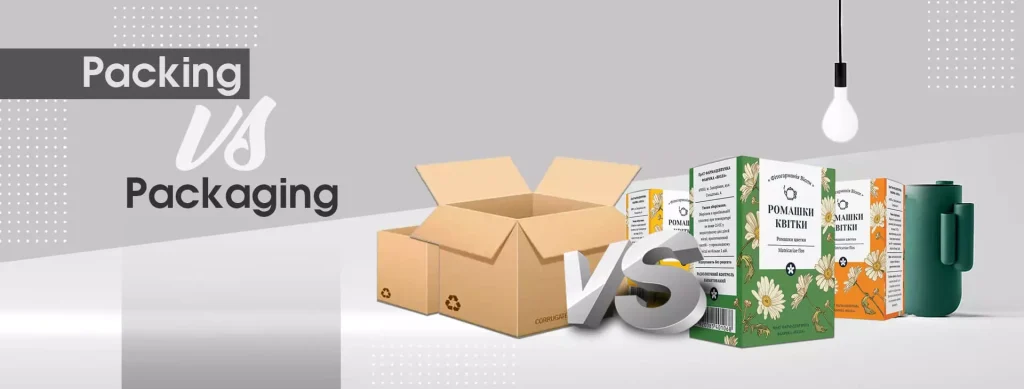Packing and packaging are often used interchangeably, but they do not have the same meaning. Packing is putting items in boxes or containers for a move, while packing has to do with enclosing goods such as food products before going into cold storage.
You’re probably wondering what the difference is between packing and packaging. Well, they are not synonymous.
Major Difference Between Packing and Packaging
The two terms may share a common origin from an Old English word “pakke,” which means “to fasten together.” Still, their meanings diverge significantly when considering how marketing strategies utilize them differently-packaging protects against scratches on surfaces like glassware. Wrapping provides the necessary protection of fragile objects during transport.
One means putting items together in a container for storage or transportation. At the same time, another refers to enclosing products with materials such as plastic wrap, foam padding material- anything that will protect it from bumps and drops during shipment.
What is Packaging? Why Need of it?
Packaging is the harmonized system of packing products for shipping, storage, logistic, and sale. It is confined to the protection of the products and pays attention to the process of design, evaluation, and production of packages.
It is said that the packaging industry has boomed more than the content, and it is the packaging that attracts the attention of potential customers. Therefore, packaging holds significant importance in the world of retail marketing.
Packaging is integral to the success of a product. Without it, products are not recognizable in stores, and customers may be less likely to buy them.
Packaging All-important for Branding
In recent years, branding has grown to be much more than selling clothing or jewelry: it’s now about making sure that you stand out among competitors with good packaging designs as well.
Excellent packages will make consumers notice them right away – hopefully enough to convince them to buy yours instead of somebody else’s product next time they need one like theirs too.
The suitable packaging can make or break your products in the market. Therefore, it’s important to use attractive colors and textures that will catch people’s attention at first glance. Still, many factors go into making it work for you long-term as well, from how often consumers purchase your product to its overall shape, size, weight, and more.
A good package is both eye-catching at first sight while also working effectively over time with less effort on marketing campaigns because not only does it look nice when customers see them–it converts sales!
With so many different companies competing against one another these days, including yours, being able to stand out amongst all those other brands could be what makes you succeed above everyone else.
Reasons Why Packaging is Required?
Packaging can make or break your product. With the rise in popularity of self-service stores and supermarkets, the packaging is often overlooked as a silent salesman for products that are not available on display.
Even if they’re popular items that everyone knows about, attractive advertising through creative packaging will help with promotion and building brand awareness to reel them in like fish (pun intended).
The all-inclusive package functions both as an advertisement for what’s inside while also keeping it safe from potential damage during shipping transit, customer handling errors at store checkouts, or even theft when left unattended elsewhere outside of the shopping environment–all before you ever have to lift a finger.
Customers are very attracted to custom packaging because it can make their purchase feel personal and memorable. The design should be personalized following the product so that customers know what they’re getting without even opening a package.
Packaging protects your goods from any external and internal harm. In addition, it secures your products from packaging shipping hazards and harsh environmental factors. Therefore, the essential purpose of packaging is to protect the products and then play its role in promotional considerations.
Have you ever noticed how your favorite TV show stories are told in different and captivating ways? For example, a series like Game of Thrones is often seen with intricate illustrations in its opening sequence.
Well, if you want to do something similar for your product packaging, there’s no need to hire an artist. Instead, making use of customizations will help tell their own story that each customer can relate to well.
Different kinds of pictures or designs on packages make it easier for customers to identify what they’re looking at by using visual cues such as color schemes and graphics while also adding uniqueness to every package design. Hence, people buy more than one item per visit. In addition, finish styles like matte coating give products a modern look, as do embellishments.
Are you tired of not being able to make a statement with your packaging? These are the benefits that you can expect from using corrugated cardboard boxes.
First, promote yourself and distinguish your product with good-looking, safe shipping containers, giving you an edge over competitors because it’s essential for them to stand out in today’s frantic marketplace. More importantly, this kind of packing is environmentally friendly too. Corrugated cardboard can be recycled into other products such as more paper or even new boxes.
Better Understanding to Know About Packing
The use of packing is expansive. It can be used for wrapping or covering items, and it has a role both in transportation and the promotion of products.
Packing is utilized to prevent goods from damage, leakage, pilferage, or breakage depending on their packaging needs; additionally, it keeps them safe during transit thanks to its protective qualities.
The main difference between packing and packaging is that packing helps carry out a specific task, but it’s much more complex with packaging.
Packaging can be an essential part of marketing your product while also ensuring protection from external forces such as moisture or temperature change, which could damage what you’re trying to sell.
Packing is an essential part of any journey. Just like the human body needs tissues throughout its entire structure, every household needs some container that can hold anything from clothes to toys. Whether you’re moving to a new house or going on vacation, there are many benefits and purposes for packing items in containers such as boxes and bags before transporting them somewhere else.
Packs have different functions depending on what it’s being used for:-
- It stores and protects your belongings when they will be transported elsewhere- whether this means across town or overseas;
- Most importantly, though, packs play a significant role in food safety by covering meats at grocery stores (as well as fruits & vegetables)
Packing is essential in the shipping of goods, but it doesn’t have any marketing value. It’s necessary to pack your products well so that they don’t get damaged during transit and make sure you package them correctly for whatever transport method you’re using; like if a product has sharp edges or fragile parts, then use bubble wrap or foam peanuts before placing these items into another box with packing paper on top.
There is more to packing than simply enclosing products. Though it offers no marketing value, the tone of voice should be informative and can make or break a product’s success on an international level.
Packing has vital roles and functions in our everyday life that go beyond its role as pure packaging for goods; However, it still matters from a global perspective without any promotional value when considering what kind of message, one wants their customers to hear about their brand.
Benefits of Packing and Packaging
Packaging and packing are different but complementary sides of the same coin. Packaging usually refers to designing, identifying a brand’s product, and marketing it while also protecting its contents for both storage or transit purposes as well as convenience. Packing is used primarily when goods need to be delivered safely to cover them with their wrapping materials.
The main purpose of packing is to ensure safety, but the packaging also serves as a powerful tool for product promotion and identification. It can increase profitability by reducing costs associated with theft or spoilage while simultaneously helping customers identify your brand more easily.
The labeling function of the package helps consumers understand how best to use your products in their homes – which could be an important factor if they’re using it around children who are likely not used to cleaning up after themselves.
The main purpose of packing is ensuring safety; however, its many functions include increasing profit margins due to cost reduction from thefts or spoiling goods and improving customer service through easy-to-understand labels on packages that help them know what’s inside without opening it first-hand.
Wrapping Up
Packaging is an essential part of any logistic management. Whether it’s packing or packaging, they all have one goal: to protect the products and see them safely delivered at their destination.
For example, while packing protects your goods from harm during transit, a good package can make even average-looking items stand out in the market by making them look attractive with clever design elements like attention-grabbing colors on logos and brands that give people strong impressions about your product before ever touching it – which is more than what you could do for just wrapping up some boxes without much thought.
Branded items are of great importance in retail marketing. You must package and label your product to make sense to buyers because if they can’t find the information about what’s inside – be at nutritional content or ingredients- then customers will not purchase them.
However, large packages also create more profit for retailers due to their visibility and a deeper cut on wholesale pricing from manufacturers, resulting in higher prices for consumers.

